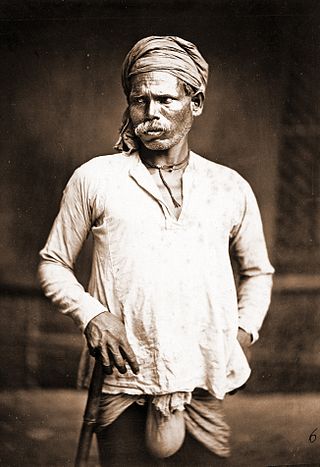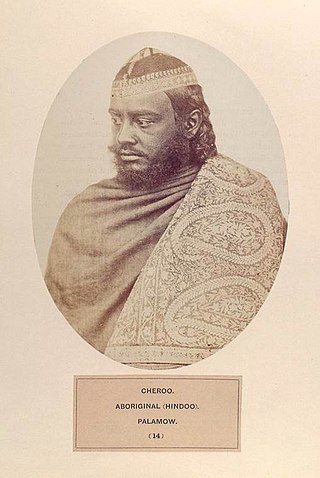
The Gondi (Gōṇḍī) or Gond people, who refer to themselves as "Koitur", are an ethnolinguistic group in India. Their native language, Gondi, belongs to the Dravidian family. They are spread over the states of Madhya Pradesh, Maharashtra, Chhattisgarh, Uttar Pradesh, Telangana, Andhra Pradesh, Bihar, and Odisha. They are listed as a Scheduled Tribe for the purpose of India's system of reservation.

The Dom, also known as Domra, Domba, Domaka, Dombara and Dombari, are castes, or groups, scattered across India. Dom were a caste of drummer. According to Tantra scriptures, the Dom were engaged in the occupations of singing and playing music. Historically, they were considered an untouchable caste called the Dalits and their traditional occupation was the disposal and cremation of dead bodies. They are in the list of Scheduled caste for Reservation in India in the Indian states of Uttar Pradesh, Bihar, Odisha, Andhra Pradesh, Jharkhand and West Bengal.

The Kharia are an Austroasiatic tribal ethnic group from east-central India. They originally speak the Kharia language, which belong to Austroasiatic languages. They are sub-divided into three groups known as the Hill Kharia, Delki Kharia and the Dudh Kharia. Amongst them, the Dudh Kharia is the most educated community.

Garhwa District is one of the twenty-four districts in the Indian state of Jharkhand. The Garhwa District is part of the Palamu division and has its administrative headquarters in Garhwa City.

Shahdol District is a district of Madhya Pradesh state in east central India. It old name was Matsya raj or Virat kingdom in the name of great king Maharaja Virata. With a total area of 6,205 km2 (2,396 sq mi) and a population of 10,66,063. Shahdol is an important district of Madhya Pradesh. The town of Shahdol is the district headquarters. The district formerly comprised Shahdol division.

There are 46 recognized Scheduled Tribes in Madhya Pradesh, India, three of which have been identified as "Particularly Vulnerable Tribal Groups" or "PTGs". The population of Scheduled Tribals (ST) is 21.1 per cent of the state population, according to the 2011 census. Bounded by the Narmada River to the north and the Godavari River to the southeast, tribal peoples occupy the slopes of the region's mountains.
Birhor are a tribal/Adivasi forest people, traditionally nomadic, living primarily in the Indian state of Jharkhand. They speak the Birhor language, which belongs to the Munda group of languages of the Austroasiatic language family.

The Chero is a caste found in the states of Bihar, Jharkhand and Uttar Pradesh in India.
Scheduled Tribes are specific indigenous peoples whose status is acknowledged to some formal degree by national legislation. Scheduled tribes of the Indian state of West Bengal, as recognized by the Constitution of the Indian Republic; a total of 40 distinct tribes. Among those 40 tribes 3 tribes are "Particularly Vulnerable Tribal Groups" (PTGs).
The Parahiya are a Hindu caste found in the state of Uttar Pradesh in North India.

Gowari is an Indian caste of cattleman or herdsmen, predominantly residing in Maharashtra, Madhya Pradesh, and Chhattisgarh.
Kharwar is a community found in the Indian states of Uttar Pradesh, Bihar, Jharkhand, Chhattisgarh, Orissa and West Bengal.

The Bhuiyan or Bhuiya or Bhouan are an indigenous community found in the Indian states of Bihar, Jharkhand, Madhya Pradesh, Odisha, Uttar Pradesh and West Bengal. They are not only geographically disparate but also have many cultural variations and subgroups.
The Patari are a community found mainly in the Sonbhadra district of Uttar Pradesh, India.

Balrampur-Ramanujganj district is a district in the Indian state of Chhattisgarh. It came into existence on 17 January 2012 and was formerly part of Surguja district. Balrampur-Ramanujganj district is the northernmost district of Chhattisgarh. Its seat is Balrampur.

Sarnaism is a religious faith of the Indian subcontinent, predominantly followed by indigenous communities in the Chota Nagpur Plateau region across states like Jharkhand, Odisha, West Bengal, Bihar, and Chhattisgarh.
Kanwar or Kawar is a tribal community found in central India, mainly in the state of Chhattisgarh, with significant populations in neighbouring areas of Maharashtra and Madhya Pradesh.
Rajwar or Rajuar is a shifting cultivation community. The people of this community mainly live in Bihar, Jharkhand, Madhya Pradesh, Odisha and West Bengal. In Odisha, they are recognized as a Scheduled Tribe, while in Bihar, Jharkhand, and West Bengal, they are classified as Scheduled Caste. In other states, the community is considered part of the Other Backward Classes (OBC) or general population.

Manendragarh-Chirmiri-Bharatpur district is a district of Chhattisgarh state in India. Earlier it was in Korea district. Manendragarh has been inaugurated as a separate District on September 9, 2022 by the Chief Minister of Chhattisgarh State Shri Bhupesh Baghel. administrative headquarters of the district is Manendragarh.

Khairagarh-Chhuikhadan-GandaiKCG is a district in the central Indian state of Chhattisgarh which consists of three cities, Khairagarh, Chhuikhadan and Gandai. It was carved out of Rajnandgaon in 2022. It is the 31st district of the state inaugurated by chief minister Bhupesh Baghel.



















